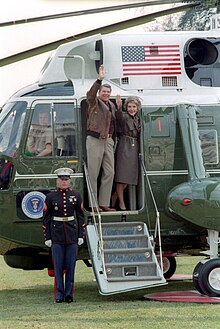Marine One




Marine One is the call sign of any United States Marine Corps aircraft carrying the President of the United States. It usually denotes a helicopter operated by the HMX-1 "Nighthawks" squadron, either the large VH-3D or the newer, smaller VH-60N Whitehawk. Both are due to be replaced by the VH-71 Kestrel, a derivative of the AgustaWestland EH101. A Marine Corps aircraft carrying the Vice President is designated Marine Two.
History
The first use of helicopters for presidential transport was in 1957, when Dwight D. Eisenhower traveled on an H-13 Sioux. This early aircraft lacked the "creature comforts" found on its modern successors, such as air conditioning and toilets.
In 1958, the H-13 was replaced by the H-34, and in 1961 by the Sea King VH-3A.
Until 1976 the Marine Corps shared the responsibility of helicopter transportation for the president with the US Army. Army helicopters used the call sign Army One while the president was on board.
Recently, the VH-53Ds were replaced by VH-60Ns. [1]
Current operations
Marine One is sometimes the preferred alternative to motorcades, which can be expensive and logistically difficult. The controlled environment of a helicopter adds greatly to the safety factor as well.
More than 800 Marines supervise the operation of the Marine One fleet, which is based in Quantico, Virginia, but is more often seen in action on the South Lawn of the White House or at Andrews Air Force Base in Maryland. At Andrews, it is sometimes used to connect to Air Force One for longer journeys. Wherever Marine One flies, it is met on the ground by at least one Marine in full dress uniform (most often two with one acting as an armed guard). In his final days of office, while flying over and landing in a remote area near the Grand Canyon, President Bill Clinton found a Marine waiting on the rock ready to salute him.[2] Marine aviators flying Marine One do not wear regular flight suits during flights, but rather the Marine Blue Dress Charlie/Delta uniform.
As a security measure, Marine One always flies in groups with identical helicopters, sometimes as many as five. One helicopter carries the president, while the others serve as decoys for would-be assassins on the ground. Upon take-off these helicopters begin to shift in formation (sometimes referred to as a Presidential shell game) regularly to keep the location of the President secure. Also, Marine One reportedly is equipped with standard military anti-missile countermeasures such as flares to counter heat-seaking missiles and chaff to counter radar-guided missiles. To add to the security of Marine One, every member of HMX-1 is required to pass a Yankee White background check before touching any of the helicopters used for presidential travel.
Marine One is always transported (as is the president's limousine) wherever the president travels, within the U.S. as well as overseas.
VH-3/VH-60 replacement
The current helicopters have aging airframes, having entered service with HMX-1 in 1962. VH-3D replaced some VH-3A in 1978, and the remainder of VH-3A were replaced by VH-60N beginning in 1989. Due to the age of the VH-3D, a replacement type is in development, with initial operational capability due by 2008 and full operational capability by no later than 2014.
The selected replacement is the AgustaWestland EH101, which will be produced by Lockheed Martin under license as the US101, with the military designation VH-71 Kestrel.
The replacement cost of the fleet was estimated at $6.1 billion when contracts were signed in 2005. However, as of March 2008 the cost of the new 28 helicoperter fleet is projected to be $11.2 billion, or roughly $400 million per helicopter. That is greater than the inflation adjusted amount paid for the Boeing 747s that serve as Air Force One. [1].
External links
- Popular Science article on Marine One
- Google Sketchup Model and Tour of New Marine One
- Google Sketchup of the Sea King version of Marine One
- Film of HMX-1 Squadron
References
- "Order 7110.65R (Air Traffic Control)" (in English). Federal Aviation Administration. 2007-03-14. Retrieved 2007-05-01.
{{cite web}}: CS1 maint: unrecognized language (link)
- ^ S-65 Origins / US Marine CH-53A & CH-53D Sea Stallion, Vectorsite.net, May 1, 2006.
- ^ Speech by Bruce Babblitt

